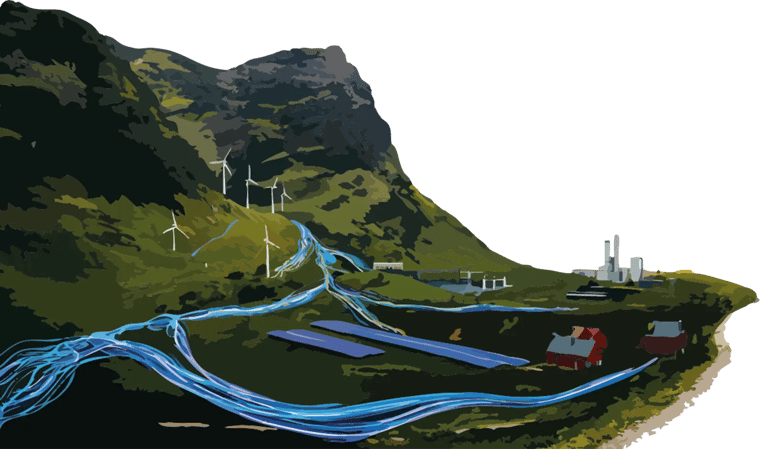
Powering a sustainable future - embracing clean electricity and sustainable energy practices
January 2024
by the 42T Sustainability Team
The transition to clean electricity and sustainable energy practices is imperative in our fight against climate change. This change will present a plethora of complex challenges, however new opportunities for businesses will arise. In our unique analysis of this evolving landscape, we’ve found that the path ahead, while fraught with obstacles, is rich with potential for innovation and strategic progress.
With the rise in science-based emissions targets – a third of global companies had set targets for the end of 2022 - today’s energy sector is undergoing a tremendous transformation, driven by a shift towards renewable sources and electrification. This transformation is revolutionising the traditional models of how we generate, distribute and store energy.

Businesses and consumers alike, fuelled by a desire to combat climate change, reduce air pollution, and lower carbon emissions, are embracing sustainable solutions like solar and wind power. However, the journey towards a greener future is not without its challenges.
The industry faces the issue of balancing the inherently intermittent and weather-dependent nature of these renewable sources, demanding innovative solutions to ensure a reliable and consistent energy supply for the future. The answer to this lies in developing smarter, more adaptive energy networks capable of managing these fluctuations.
Simultaneously, the electrification of various sectors is leading to an unprecedented increase in demand on the electricity network. This upsurge demands a rethinking of how we distribute and store energy. Traditional energy infrastructure, which has been predominantly one-way, is now transforming to accommodate a more distributed and dynamic energy landscape.
This evolution is not without its hurdles; the infrastructure must now support two-way energy flows, catering to both the generation and storage of renewable energy at localised points.
The 42T team is seeing that, at the heart of this transition, is the need for businesses to rethink energy usage. The focus is shifting towards developing products and processes that are not only energy-efficient but also contribute to the management of energy use.
This includes innovations in energy monitoring and management systems that can significantly reduce consumption and improve efficiency. Businesses, in adapting to these changes, are recognising that strategic planning around energy use is no longer an option but a requisite.
This shift is essential not just for compliance with emerging regulations but also for maintaining competitiveness in an increasingly environmentally conscious market.
The increasing consumer demand for energy-efficient products, highlighted by the rapid growth in electric vehicle sales (from 4% of total car sales in 2020 to 14% in 2022) and the fact that 56% of consumers take environmental sustainability into account when purchasing white goods, illustrates this necessity. Businesses must innovate to stay ahead of their competitors. This involves embracing new technologies and rethinking traditional business models to align with the changing energy landscape.
The commitment to this transition is evident in the growing number of companies pledging to reduce their emissions. This trend signifies an industry-wide acknowledgement of the importance of sustainable energy practices. We are actively engaged in assisting businesses in this transition. Our involvement ranges from fuel-switching initiatives to reducing energy consumption in production processes, demonstrating practical applications of sustainable energy practices.
In the past, we have completed concept work transforming a beverage production process, showcasing our commitment to energy efficiency. By re-engineering this process, we significantly reduced energy consumption, demonstrating how thoughtful innovation can lead to both environmental and economic benefits.
As we cast our gaze towards the imminent future, the urgency in the evolving energy landscape cannot be overstated. We are at a critical juncture where the escalating demand for energy-efficient products, the rapid emergence of new technologies for managing energy generation, storage, and distribution, as well as developing cutting-edge, energy-efficient solutions signal a transformative era.
This is far more than a mere response to the challenges brought forth by the energy transition; it is a crucial, proactive embrace of the opportunities that these changes necessitate. Businesses that recognise and adapt to these changes will not only contribute to a more sustainable world but will also discover new markets and opportunities in an energy-conscious global economy. Meanwhile, businesses that fail to rise to these challenges will be rapidly left behind. The path ahead is clear: to innovate and adapt, ensuring a future where sustainable energy is not just a goal but a reality.
Was this trend article useful? Have a challenge of your own?
Email answers@42technology.com or give us a call on +44 (0)1480 302700.
Share this article:
Related Articles

Consumer, Sustainability
The refillable revolution - the sustainable future of grocery shopping

Sustainability, Industrial
The surge in the global Blue Economy - what role for deep tech?

Sustainability, Industrial
The hydrogen economy - solving difficult challenges towards energy transition

What will you ask us today?
We believe in asking the right questions to drive innovation; when we know the right questions, we generate the ideas to answer them.





